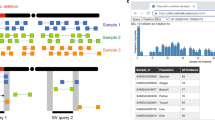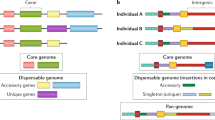Abstract
There is a concerted effort by a number of public and private groups to identify a large set of human single-nucleotide polymorphisms1,2 (SNPs). As of March 2001, 2.84 million SNPs have been deposited in the public database, dbSNP, at the National Center for Biotechnology Information (http://www.ncbi.nlm.nih.gov/SNP/). The 2.84 million SNPs can be grouped into 1.65 million non-redundant SNPs. As part of the International SNP Map Working Group, we recently published a high-density SNP map of the human genome consisting of 1.42 million SNPs (ref. 3). In addition, numerous SNPs are maintained in proprietary databases. Our survey of more than 1,200 SNPs indicates that more than 80% of TSC and Washington University candidate SNPs are polymorphic and that approximately 50% of the candidate SNPs from these two sources are common SNPs (with minor allele frequency of ≥20%) in any given population.
This is a preview of subscription content, access via your institution
Access options
Subscribe to this journal
Receive 12 print issues and online access
$209.00 per year
only $17.42 per issue
Buy this article
- Purchase on Springer Link
- Instant access to full article PDF
Prices may be subject to local taxes which are calculated during checkout
Similar content being viewed by others
References
Collins, F.S., Guyer, M.S. & Chakravarti, A. Science 278, 1580–1581 (1997).
Marshall, E. Science 284, 406–407 (1999).
The International SNP Map Working Group Nature 409, 928–933 (2001).
Altshuler, D. et al. Nature 407, 513–516 (2000).
Taillon-Miller, P., Gu, Z., Li, Q., Hillier, L. & Kwok, P.-Y. Genome Res. 8, 748–754 (1998).
Marth, G.T. et al. Nature Genet. 23, 452–456 (1999).
Taillon-Miller, P. & Kwok, P.-Y. Genome Res. 9, 499–505 (1999).
Rozen, S. & Skaletsky, H. Methods Mol. Biol 132, 365–386 (2000).
Kwok, P.-Y., Carlson, C., Yager, T., Ankener, W. & Nickerson, D.A. Genomics 23, 138–144 (1994).
Taillon-Miller, P. et al. Nature Genet. 25, 324–328 (2000).
Acknowledgements
We thank E.P.H. Yap for the Asian samples; M. Boyce-Jacino for the Caucasian and African American samples; R. Sachidanandam and L. Stein for TSC sequence information; and S. Sherry and E.H. Lai for discussion. This work is funded in part by grants from the National Human Genome Research Institute (HG01720) and the SNP Consortium.
Author information
Authors and Affiliations
Corresponding author
Rights and permissions
About this article
Cite this article
Marth, G., Yeh, R., Minton, M. et al. Single-nucleotide polymorphisms in the public domain: how useful are they?. Nat Genet 27, 371–372 (2001). https://doi.org/10.1038/86864
Received:
Accepted:
Issue Date:
DOI: https://doi.org/10.1038/86864
This article is cited by
-
Targeted SNP discovery in Atlantic salmon (Salmo salar) genes using a 3'UTR-primed SNP detection approach
BMC Genomics (2010)
-
Automated SNP detection from a large collection of white spruce expressed sequences: contributing factors and approaches for the categorization of SNPs
BMC Genomics (2006)
-
Single nucleotide polymorphism (SNP) discovery in duplicated genomes: intron-primed exon-crossing (IPEC) as a strategy for avoiding amplification of duplicated loci in Atlantic salmon (Salmo salar) and other salmonid fishes
BMC Genomics (2006)
-
A candidate gene approach to searching for low-penetrance breast and prostate cancer genes
Nature Reviews Cancer (2005)
-
Single-nucleotide polymorphisms in genes relating to homocysteine metabolism: how applicable are public SNP databases to a typical European population?
European Journal of Human Genetics (2005)



